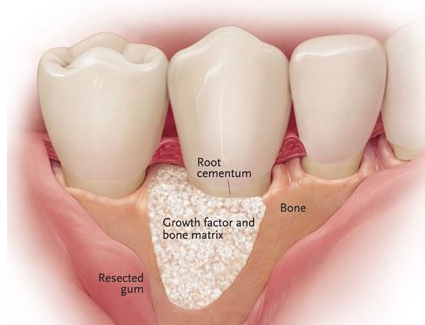Periodontal surgery is a plastic (reshaping) surgical procedure designed to restore and regenerate normal form and function of the gum tissue, periodontal ligament and bone. Periodontal surgery is not a cure, but rather an adjunct to making long-term treatment outcomes more favourable. The long-term goal of periodontal surgery is to increase the life expectancy of the teeth through improving oral hygiene habits, cessation of smoking and other lifestyle changes, tartar (calcus) removal and occlusal bite therapy to stabilise loose teeth prior to and after surgeries.

Types of surgical procedures
Type of surgical periodontal procedure selection depends on the type and severity of the gum disease.
Root Planning
Root planning procedure removes tartar accumulated on the root surfaces making it smooth. Smooth and easy to clean root surfaces prevents further tartar and bacterial build up and maintain the periodontal health.
Flap surgery
Flap surgery is indicated for patients who have tartar deposits in deep pockets. Flap surgery involves lifting the gums off of the teeth under the local anaesthesia, to remove tartar build-up.
After removal of tartar and inflamed gingival tissue (gingivectomy) periodontal pockets are eliminated. We stitch the gums into place to fit around the teeth. Sometimes, the bone may require contouring during this procedure.
Bone grafting
Bone grafting is required when the bone that surrounds the root of the tooth is damaged or destroyed. This procedure involves replacing the damaged bone with new bone substitutes. This bone may be the person’s bone, a manufactured bone, or donated bone
The goal of bone grafting is to hold the tooth in place and help it to regrow.
Guided tissue regeneration
During this procedure, we will place a small piece of mesh-like material between the bone and gum tissue. This graft material prevents the gum from growing into space where bone should be, allowing the bone and connective tissue to regrow in the desired form.
The goal of guided tissue regeneration is to grow the new bone and increase the support around tooth.
Tissue grafting
Free Gingival Graft / Connective Tissue Graft
The type of surgery performed will be based on several factors, such as the condition of the gums.
A lowered gum line, known as gum line recession, is caused by the loss of gum tissue and may require soft tissue grafting to reduce the risk of further damage.
During this procedure, we typically remove tissue from one part of mouth and re-attaches it to the area where the gum has receded. The tissue often is harvested from the roof of the mouth.
Tissue grafting not only reduces the risk for further damage but also covers any exposed roots or dental implants.

